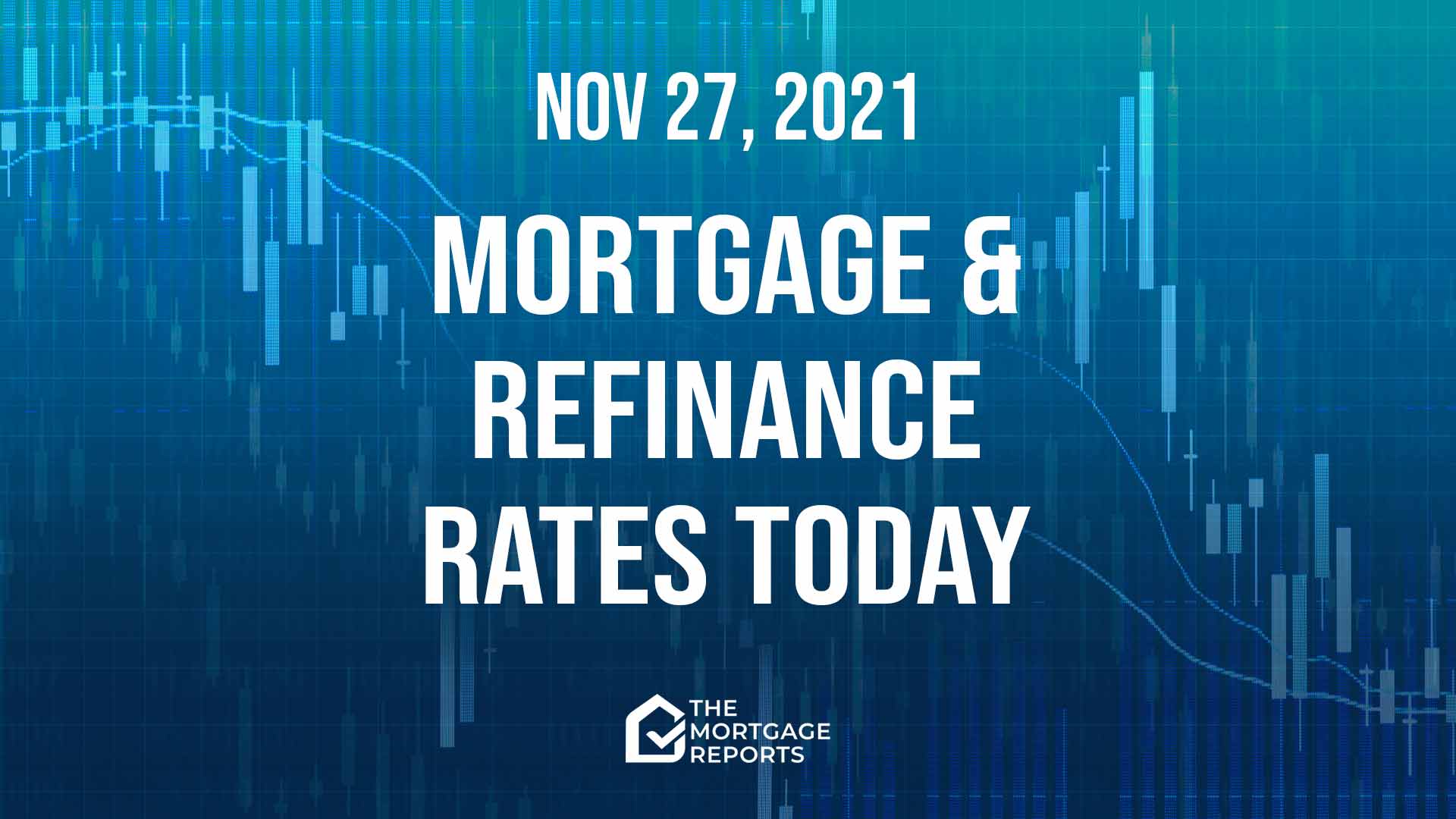
Today’s mortgage and refinance rates
Average mortgage rates fell moderately yesterday. But they rose over the week.
However, things are different now from earlier in the week. And there’s a good chance that mortgage rates will fall next week. But whether that’s the case will depend on still emerging news concerning the new Omicron COVID-19 variant.
Find and lock a low rate (Nov 27th, 2021)Current mortgage and refinance rates
| Program | Mortgage Rate | APR* | Change |
|---|---|---|---|
| Conventional 30 year fixed | |||
| Conventional 30 year fixed | 3.348% | 3.367% | -0.08% |
| Conventional 15 year fixed | |||
| Conventional 15 year fixed | 2.761% | 2.79% | -0.07% |
| Conventional 20 year fixed | |||
| Conventional 20 year fixed | 3.198% | 3.233% | -0.08% |
| Conventional 10 year fixed | |||
| Conventional 10 year fixed | 2.732% | 2.787% | -0.05% |
| 30 year fixed FHA | |||
| 30 year fixed FHA | 3.474% | 4.242% | -0.07% |
| 15 year fixed FHA | |||
| 15 year fixed FHA | 2.772% | 3.417% | -0.08% |
| 5/1 ARM FHA | |||
| 5/1 ARM FHA | 2.594% | 3.217% | -0.06% |
| 30 year fixed VA | |||
| 30 year fixed VA | 3.287% | 3.483% | -0.11% |
| 15 year fixed VA | |||
| 15 year fixed VA | 2.842% | 3.185% | -0.17% |
| 5/1 ARM VA | |||
| 5/1 ARM VA | 2.5% | 2.473% | -0.04% |
| Rates are provided by our partner network, and may not reflect the market. Your rate might be different. Click here for a personalized rate quote. See our rate assumptions here. | |||
Should you lock a mortgage rate today?
Most markets were hit by a metaphorical express train yesterday. That took the form of a new variant of the coronavirus, dubbed “Omicron” by the World Health Organization (WHO). Read on to discover my thoughts on what it might mean for mortgage rates.
If Omicron takes off in the way some scientists fear, lower mortgage rates are likely to follow. But it’s too soon to be sure this isn’t a false alarm. So I’m leaving my personal rate lock recommendations in place for now. But I wouldn’t lock my rate until the situation’s clearer if I were you.
So, for now, those recommendations remain:
- LOCK if closing in 7 days
- LOCK if closing in 15 days
- LOCK if closing in 30 days
- LOCK if closing in 45 days
- LOCK if closing in 60 days
However, with so much uncertainty at the moment, your instincts could easily turn out to be as good as mine — or better. So be guided by your gut and your personal tolerance for risk.
What’s moving current mortgage rates
Last week, I suggested that a winter wave of COVID-19 infections might bring lower mortgage rates for as long as it lasted. But the new Omicron variant (aka B.1.1.529) caught me and the rest of the world by surprise.
Yesterday, BBC News explained that there were already thousands of COVID-19 variants in circulation. But most of them had very similar effects on humans. It continued:
But this new variant has experts particularly worried because it is very different from the original Covid, which current vaccines were designed to fight. It has a long list of genetic changes — 50 in all. Of these, 32 are in the spike protein of the virus — the part which is the target of vaccines. However, it is too soon to know how much of a threat B.1.1.529 poses.
— BBC News, “What are the Covid variants and will vaccines still work?,” Nov. 26, 2021
Existing vaccines were precisely engineered to protect against existing variants. So nobody’s yet sure how effective they’ll be against Omicron’s new spike protein.
Most experts think they’ll still provide some protection. For example, The Guardian overnight reported:
The director of the Oxford Vaccine Group, which developed the AstraZeneca vaccine, expressed cautious optimism that existing vaccines could be effective at preventing serious disease from the Omicron variant and said it is unlikely to result in a reboot of the pandemic.
The Guardian, “Covid Live,” Nov. 27, 2021
But other scientists are more fearful. And all we know for certain is that nobody’s sure about much.
Not here — yet
The new variant was first identified in South Africa, though that may be a result of its sophisticated virus-monitoring resources. But there are already confirmed cases in Hong Kong, Israel and the UK. And there are suspected cases in the Czech Republic and Germany.
Meanwhile, when two flights from South Africa landed in the Netherlands overnight, 61 passengers tested positive for COVID-19, though it will take time to discover how many, if any, had the new variant. A New York Times reporter who was on one of those flights reported that as many as one-third of passengers defied the airline’s mask mandate.
There are no reported cases in the US so far. And the government is banning flights from South Africa and seven other countries starting Monday.
Omicron’s impact on markets and mortgage rates
You probably already know that markets hate few things more than uncertainty. And most responded sharply yesterday to news reports about Omicron. For example, the Dow recorded its worst-ever Black Friday.
The Wall Street Journal explained what happened to bonds:
Investors piled into government bonds and quickly recalibrated their expectations for interest-rate increases in response to the new COVID-19 variant first identified in South Africa. The yield on the 10-year U.S. Treasury note dropped to 1.484% Friday, according to Tradeweb, from 1.644% at Wednesday’s close. That marks the largest trading-session decline since March 2020, at the start of the coronavirus pandemic. Yields fall as bond prices rise.
— WSJ, “COVID-19 Variant Upends Investor Bets on Rate Increases,” (paywall) Nov. 26, 2021
That’s a huge one-day drop by any standards, but especially on a day when the market closed at lunchtime. And yet mortgage rates dropped only moderately.
How come? Well, it may be that some lenders didn’t adjust their rate cards that day to reflect the scale of the drop in the market for mortgage-backed securities, which is the type of bond that largely determines mortgage rates.
And, if that’s the case, we may well see some more — perhaps sharp — falls in mortgage rates today and next Monday morning.
And I’d expect low mortgage rates to last — and lower mortgage rates to be the short-term trend — at least until scientists better understand Omicron’s likely impact on health and the economy. And that might take weeks.
Further ahead
If it weren’t for the pandemic, mortgage rates would almost certainly be heading higher. Because the economic news (including data released earlier this week) all shows a strong economic recovery. And a strong economy and higher mortgage rates almost always go hand in hand.
True, you could argue that warm inflation is a weakness rather than a strength. But that, too, typically brings higher interest rates.
So, if mortgage rates fall again, it will be down to COVID-19. That might be because the Omicron variant proves as dangerous as some fear. Or it may be because a new winter wave in infections causes economic disruption. Or both.
Economic reports next week
We’ll see some important economic reports next week, including the monthly employment situation report. But, if markets remain spooked by Omicron, they might all be shrugged off.
The key ones below are in bold. But none of the other economic reports listed below is likely to cause much movement in markets unless it includes shockingly good or bad data:
- Monday — October pending home sales
- Tuesday — November consumer confidence index
- Wednesday — November ADP employment report (private sector jobs) and the Institute for Supply Management (ISM) manufacturing index. October construction spending
- Thursday — Weekly new claims for unemployment insurance to Nov. 27
- Friday — November employment situation report, comprising nonfarm payrolls, unemployment rate and average hourly earnings. Plus ISM services index for November. And October’s factory orders
Friday would normally be a highly important day. But investors may be too obsessed by Omicron to notice.
Find and lock a low rate (Nov 27th, 2021)
Mortgage interest rates forecast for next week
Mortgage rates might fall next week. And it’s all down to the Omicron COVID-19 variant.
Mortgage and refinance rates usually move in tandem. And a gap that had grown between the two has been largely eliminated by the scrapping of the adverse market refinance fee.
Meanwhile, another recent regulatory change has likely made mortgages for investment properties and vacation homes more accessible and less costly.
How your mortgage interest rate is determined
Mortgage and refinance rates are generally determined by prices in a secondary market (similar to the stock or bond markets) where mortgage-backed securities are traded.
And that’s highly dependent on the economy. So mortgage rates tend to be high when things are going well and low when the economy’s in trouble.
Your part
But you play a big part in determining your own mortgage rate in five ways. And you can affect it significantly by:
- Shopping around for your best mortgage rate — They vary widely from lender to lender
- Boosting your credit score — Even a small bump can make a big difference to your rate and payments
- Saving the biggest down payment you can — Lenders like you to have real skin in this game
- Keeping your other borrowing modest — The lower your other monthly commitments, the bigger the mortgage you can afford
- Choosing your mortgage carefully — Are you better off with a conventional, FHA, VA, USDA, jumbo or another loan?
Time spent getting these ducks in a row can see you winning lower rates.
Remember, it’s not just a mortgage rate
Be sure to count all your forthcoming homeownership costs when you’re working out how big a mortgage you can afford. So focus on your “PITI.” That’s your Principal (pays down the amount you borrowed), Interest (the price of borrowing), (property) Taxes, and (homeowners) Insurance. Our mortgage calculator can help with these.
Depending on your type of mortgage and the size of your down payment, you may have to pay mortgage insurance, too. And that can easily run into three figures every month.
But there are other potential costs. So you’ll have to pay homeowners association dues if you choose to live somewhere with an HOA. And, wherever you live, you should expect repairs and maintenance costs. There’s no landlord to call when things go wrong!
Finally, you’ll find it hard to forget closing costs. You can see those reflected in the annual percentage rate (APR) you’ll be quoted. Because that effectively spreads them out over your loan’s term, making that higher than your straight mortgage rate.
But you may be able to get help with those closing costs your down payment, especially if you’re a first-time buyer. Read:
Down payment assistance programs in every state for 2021



